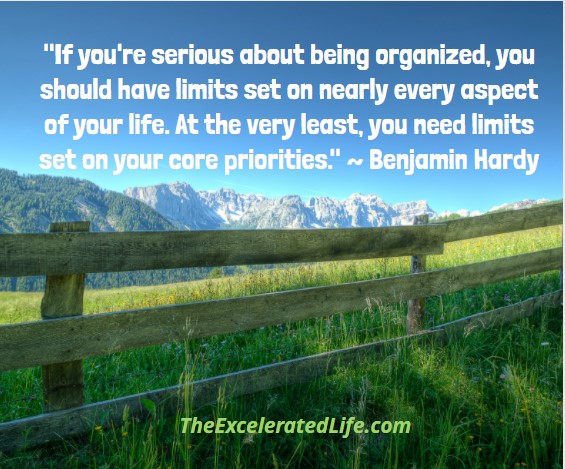There are limits in goal setting that can actually help you reach your goals. We call these “floors” and “ceilings”. When you are developing new habits in relation to your goal steps, these upper and lower limits, plus a special kind of limit called a “bright line” can help turn new behaviors into habits.
TheExceleratedLife.com
Title Photo by gdtography from Pexels
Set Goals, Not Limits?
Tom Clifford is a running coach who has worked with a number of Olympic athletes. In a blog post entitled “Set Goals, Not Limits”, Tom writes “I think one thing we struggle with is limiting our goals, staying in our comfort zone or not thinking we can attain something because we are not talented enough, or have the right connections, or a million other excuses people tell themselves of why they will never get to the next level.” [Clifford] A limit, Tom says, is the boundary you believe it is impossible to go beyond.
And I agree with Tom that it’s a mistake if we don’t pursue our dream because we don’t have enough money, we don’t know the right people, we don’t have the education, we haven’t had the lucky breaks. Because those are methods – the tools (actions, behaviors, information, items) we use to reach our intentions. And we don’t want to limit our goals to the methods we already have.
But that is only one type of limit. There are other limits that can actually help us reach our goals. We call these “floors” and “ceilings”. And when you are developing new habits in relation to your goal steps, these upper and lower limits, plus a special kind of limit called a “bright line” can help turn new behaviors into habits. Let’s take a look at how limits and bright lines lead to the habits that help you reach your goals.

Floors And Ceilings
When you are developing new habits, it helps to identify floors and ceilings. In some cases, you’ll want to set a lower limit, a floor. Sometimes, you’ll set an upper limit, a ceiling.
Your floor is the minimum amount you’ll do a specific action. Think of Stephen Guise starting his workout routine mini habit by doing 1 pushup. [Guise] These are the actions you’ll want to do at least a certain number of times.
The ceiling is your upper limit, the maximum number of times you’ll do something. Typically, this is a way to control how much time, money, energy, and effort you spend on a particular action.
(Another ceiling represents your highest potential, the thing you are striving for. This could be your outcome goal. But this isn’t the ceiling we’re interested in today.)

Floor: The Lower Limit
The floor is the absolute bottom limit; you’ll do at least this much and you may do more. As we discussed earlier, this is the basis of tiny habits.
Lower limits look like this.
- Do 1 pushup.
- Walk 5000 steps per day.
- Work out three days per week. (Bonus points if you name the days, eg., work out Tuesday, Thursday, and Saturday.)
- Save $1.00 per day.
- Write 50 words per day.
You get the idea. Now, think about your BIG goal and think about the tiny steps you need to take to get there. What’s the lower limit for your next step?
Ceiling: The Upper Limit
Use your ceiling when you want to limit the number of times you’ll do a certain action. This is mostly helpful when you want to break an unhealthy habit or to improve how you’re using your time, money, and energy.
The ceiling is an upper limit – you’ll do no more than this. For example:
- Have no more than 50 emails in my inbox.
- Spend 30 minutes or less on Facebook each day.
- Eat sugary sweets no more than twice a week.
- Watch TV for 1 hour per day or less.
- Eat out no more than twice per week.
Think about your BIG goal again. Is there a ceiling that will help you limit actions that impede you from reaching your goal?
Bright Lines
Bright lines are rules we put in place for ourselves that help us to resist temptation. The concept comes from the legal profession. A bright-line rule is “a clearly defined rule or standard, generally used in law, composed of objective factors, which leaves little or no room for varying interpretation.” [Wikipedia] Bright lines are simple and unambiguous rules. The purpose of a bright-line rule is to produce predictable and consistent results with its application.
Bright-line rules are powerful, Zaid K. Dahhaj writes in the article “The Power Of Creating Bright Lines In Your Life”, for these reasons:
- They are clear rules. We know exactly what we need to do or need to avoid; there’s no wiggle room.
- They provide immediate feedback. We know right away if we keep the rule or break it, and we can quickly make adjustments for next time.
- They are practical. Once you commit to following a bright-line rule, you remove the need to go through the decision-making process each time you face the situation.
[Dahhaj]
Here are some bright-line examples.
- I go to bed by 9:30 PM.
- I wait 24 hours before buying anything that costs $100 or more.
- I don’t eat highly processed foods.
- I stay within my entertainment budget each month.
- (Ceiling = I spend $100 or less on entertainment each month.)
- I don’t tell lies.
- I do what I say I will do.
Putting It All Together
Reaching your BIG (Bold-Important-Gratifying) goals is a matter of taking tiny steps consistently day after day, week after week, month after month. Your limits, floors and ceilings, and bright lines help you take those steps.
Your BIG goal is a stretch, something to pull you out of your comfort zone, something that requires you to learn and grow. And that’s good. That is Excelerated Goal Setting™. But the very nature of these goals can cause us to freeze and hesitate to take the steps we must take to be successful.
Here’s how to approach them. Have your BIG goal, the outcome goal you want to eventually reach. Then, design your steps, your process goals, the tiny advances you’ll make each day until you achieve your target. Here is where you’ll set up your floor or ceiling and perhaps develop some bright-line rules to ensure you make your daily progress. Now, you’re on your way.
How Do I Start?
You start naturally with your BIG goal. (Don’t have a BIG goal yet? Try this Goal Setting JumpStart. Or for a full-blown plan, use the Goal Setting Excelerator.)
Your BIG goal is likely an outcome goal. If it is, let’s turn it into a process goal.
Once you have your process goal in place, what step will you take every day to work the process?
Now, work to make your process step into a habit.
- What’s your floor, the least you’ll do to take the step?
- What’s your ceiling? The outcome goal is one, but what’s your process when you’re firing on all cylinders?
- Is there a bright line you can put in place?
For example, let’s say your outcome goal is to lose weight – 20 pounds.
Two of your process goals are to walk every day and to eat mostly whole foods.
A floor could be: I walk at least 5000 steps every day.
A ceiling might be: I have dessert no more than twice a week.
A bright-line: I don’t buy junk food at the grocery.
Or suppose your goal is to get a promotion at work.
A couple of process goals could be to take on more responsibility and to complete all paperwork at least a day before it is due.
One floor is: I find a way to make one small improvement in my productivity each week.
A ceiling could be: I spend one hour or less responding to e-mail each day.
A bright-line: I always arrive at work 10 minutes early.
Limits And Bright Lines Help Create Habits
If you try to change your behavior in pursuit of your BIG goals using mainly willpower, you’re most likely headed for failure. But if you can turn your desired behaviors into habits, you’ll perform them consistently without thinking too much about them.
How can using floors, ceilings, and bright lines help with habit formation? As we’ve seen, each of these techniques can help you set a baseline – either a lower limit or an upper limit, depending on if you want to do “at least” or “no more than”. This helps you create the tiny actions that easily lead to habits. And when you draw a bright line, you have a clear understanding of what you must do or must not do on your way to creating the habit.
Habits come at the intersection of knowledge – what to do, skill – how to do, and desire – want to do. Floors, ceilings, and bright lines are particularly useful with the how to do part. You can read more about creating desirable habits in The Excelerated Life Source Book or in the Excelerated Habits™ blog posts. Because practicing the skill of creating healthy, beneficial habits is one step in embracing your Excelerated Life™!
Excelerated Habits™ — automating your best behaviors — is one step in creating your Excelerated Life™, a life of flourishing and well-being, and a life of meaning, purpose, and service.
Read more about the Excelerated Life™.
Resources:
“Bright-line Rule.” Wikipedia, The Free Encyclopedia. Wikimedia Foundation, Inc., 12 December 2017. Web. 30 January 2019.
http://en.wikipedia.org/wiki/Bright-line_rule.
Clifford, Tom. “What is SET GOALS NOT LIMITS?” Without Limits. Without Limits,
January 25, 2014. Web. February 4, 2022.
https://www.iamwithoutlimits.com/what-is-set-goals-not-limits/
Dahhaj, Zaid K. “The Power Of Creating Bright Lines In Your Life.” Mission.org. A Medium Corporation, September 10, 2018. Web. February 4, 2022
https://zaidkdahhaj.medium.com/the-power-of-creating-bright-lines-in-your-life-b2f1c92ee5d
Guise, Stephen. Mini Habits: Smaller Habits, Bigger Results. CreateSpace Publishing. 2013.
Hardy, Benjamin. Willpower Doesn’t Work. New York: Hatchette Book Group, Inc, 2018.


